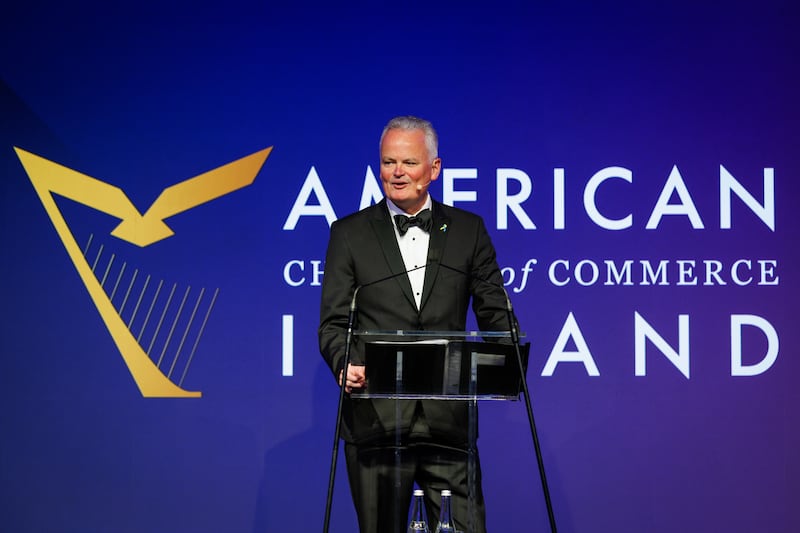By any standards, 2022 was a stellar year for US investment in Ireland, and the future is looking bright. “It was a very strong year,” says Mark Redmond, chief executive, American Chamber of Commerce Ireland (AmCham). “And we are still seeing great confidence in Ireland as a location for US foreign direct investment (FDI): 92 per cent of the boards of companies with a presence in Ireland see this country as very attractive for future investment; 64 per cent are going to increase headcount, 31 per cent are going to maintain it, and only 5 per cent are contemplating a reduction in the next 12 months.”
Those sentiments are already translating into new investments, he notes. “On the back of a record year in 2022, American Chamber members made capital investments of €3 billion in Ireland and announced 4,000 new jobs during the first half of 2023. The indications for the remainder of 2023 are very positive.”

Overall FDI employment continues to grow as well. “Total employment in FDI companies exceeded 300,000 for the first time in 2022″, he points out. “That was a 9 per cent increase on the previous year.”
He acknowledges the difficulties experienced by the tech sector over the past year or so. “While there have been unfortunate job losses for individuals in the tech sector, that is still only 2 per cent of the total number employed in the sector here. The majority of people affected have found new and exciting roles since.”
READ MORE
Investment relationship
The investment relationship is very much two-way. “Irish companies are extremely active in the US,” Redmond emphasises. “Ireland is now the ninth biggest investor in the US and Irish companies now employ more than 100,000 people there. That was a point stressed by President Biden during his visit to Ireland in April.”
Investment in Ireland is not without its challenges, of course. While overall sentiment towards Ireland in American companies’ boardrooms is generally very positive, there are concerns relating to Ireland’s infrastructural capacity and other issues. “One hundred per cent of US multinationals located here see availability of residential accommodation as a challenge. They also see availability of key talent critically important for growing and maintaining investment in Ireland.”
Redmond believes Ireland has the capacity and the ability to meet these challenges. “Ireland is not full,” he says. “The latest census shows the population is only returning to its mid-19th century level. Our population density is much lower than the European average and is about one-third that of England, Belgium and the Netherlands. Ireland has capacity for population growth, but we need to make smart choices about investment. We need to make smart choices about where people live and learn and bring healthcare closer to people. And we need to utilise our resources to become a net energy exporter.”
Digital opportunities
He also believes Ireland has an opportunity to become a leader in the digitalisation of public services. “We have an excellent example in the passport service and what has been achieved there,” he points out. “Digitalisation makes services more efficient and accessible for individuals and businesses. Joined up public services help companies become more competitive. We have all the world’s leading digital companies here and we are making real strides on the rollout of broadband. We present ourselves rightly as the digital heart of Europe. The passport service shouldn’t be the exception, it should be the norm.”
There are opportunities in other areas as well. “There is a massive opportunity to digitalise the health service through joined-up information and data. Ireland can become a global centre for medical research and the delivery of digital healthcare. Ireland is already a centre of excellence for medtech. Companies here are producing injectable devices for diabetes patients which are connected to smartphones and doctors’ IT systems.”
Ireland’s ageing population can also offer opportunities, he believes. “Ireland can become a centre of excellence for how an ageing population can be better looked after and treated for the clinical challenges associated with ageing. There is an opportunity there to be seized.”
Looking to 2050
He welcomes the progress being made on reforms to the planning system. “It is great to see that determination to modernise the planning administration and legal frameworks. We have seen some inordinate delays for projects and Ireland has definitely suffered reputationally as a result of losing projects due to delays in the planning process. People have a right to expect certainty of process and timelines, not certainty of outcomes.”
Legislative reform is only part of the equation, he adds. “There is no point in amending the law and the processes if we don’t invest in resources and ensure the system has the skills and capability to do the job.”
For the longer term, he says there is a need to look forward to what the country needs in 2050. “It is looking like we are going to have a population of eight million. We will still have quite a low population density, but it will be a massive increase over the course of a century. We had a population of three million in 1950. We need to look at what infrastructure and services will be required to support that population. That requires rethinking where people might want to live, where they will want to learn, and where they want to access healthcare. Transport issues will also have to be addressed to allow people get to and from work and access the services they need. Let’s put in place the elements required to have a great country to live in for eight million people in 2050. And let’s be really purposeful about that.”














